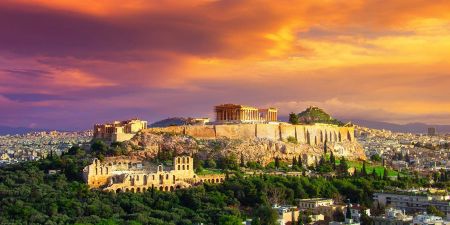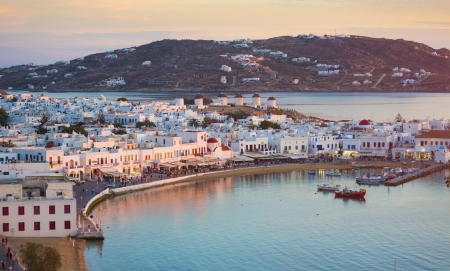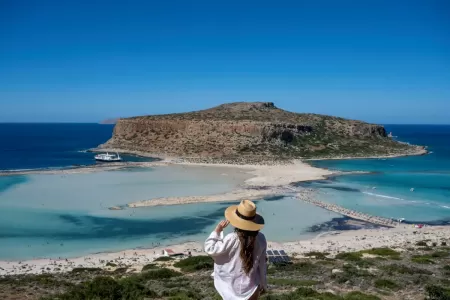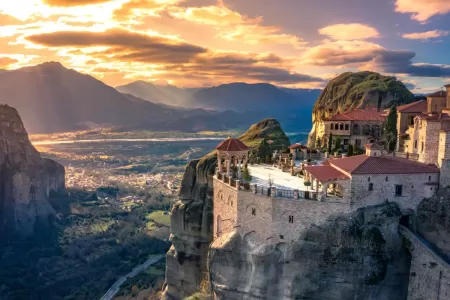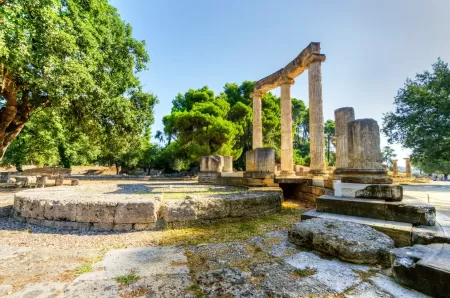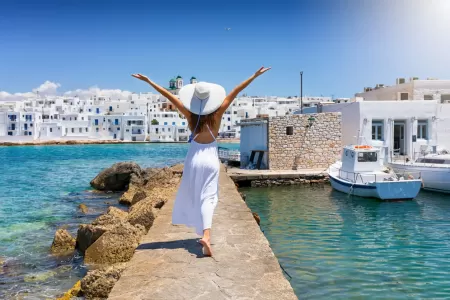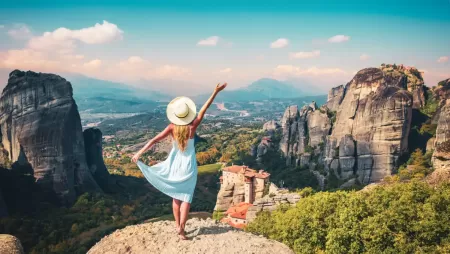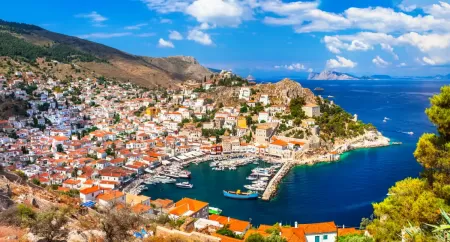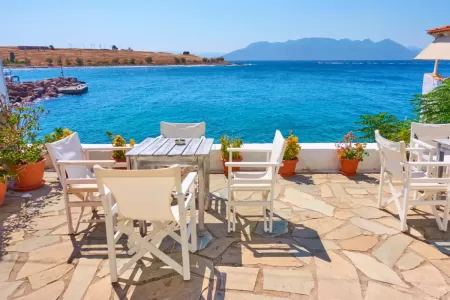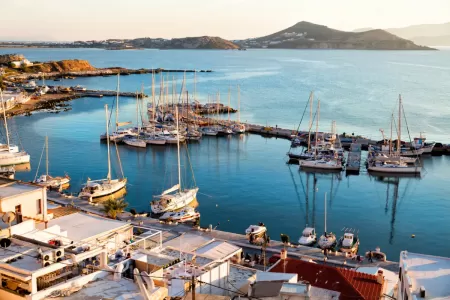The Perfect First-Timer's Guide to Santorini Greece
Santorini Greece attracts an astonishing 2 million tourists annually, making it the most popular Greek destination and a worldwide famous island. This breathtaking Cycladic gem sits approximately 128 nautical miles southeast of the Greek mainland, captivating visitors with its dramatic caldera views formed by a massive volcanic eruption around 1500 BC.

Santorini Greece attracts an astonishing 2 million tourists annually, making it the most popular Greek destination and a worldwide famous island. This breathtaking Cycladic gem sits approximately 128 nautical miles southeast of the Greek mainland, captivating visitors with its dramatic caldera views formed by a massive volcanic eruption around 1500 BC.
As a first-time visitor, you'll discover that the best things to do in Santorini range from exploring the ancient city of Akrotiri (often called the "Greek Pompeii") to relaxing on unique volcanic beaches with black and red sand. During July and August, the island certainly becomes crowded, which is why many experienced travelers recommend visiting during the quieter shoulder seasons from late April to June or September to October. While Santorini is particularly renowned for its stunning sunsets, it also boasts exceptional wine production, especially the indigenous Assyrtiko grape variety, celebrated for its distinctive mineral qualities.
What Makes Santorini Unique: A Quick Overview
The dramatic landscape of Santorini Greece stands as a testament to one of history's most powerful volcanic eruptions. Unlike any other destination in the Mediterranean, this crescent-shaped wonder emerged from a cataclysmic volcanic event that forever shaped its identity.
The island's volcanic history and caldera views
At the heart of Santorini's uniqueness lies its extraordinary geological formation. The island you see today exists because of a massive volcanic eruption approximately 3,600 years ago (around 1600 BCE). This catastrophic event, known as the Minoan eruption, was one of the largest volcanic explosions in recorded history.
The aftermath created Santorini's most distinctive feature – a magnificent caldera measuring roughly 12 km by 7 km with steep 300-meter cliffs encircling three sides. This submerged volcanic crater reaches depths of 385 meters below sea level. What makes this geological wonder truly remarkable is that visitors can actually sail into the interior of a volcanic caldera – an experience unavailable anywhere else in the world.
Furthermore, two small volcanic islands, Nea Kameni and Palea Kameni, have formed at the center of the caldera through subsequent eruptions, with the most recent occurring as recently as 1950. These islands represent the volcano's ongoing activity and contribute to the otherworldly seascape that captivates travelers.
Why Santorini is different from other Greek islands
Beyond its geological marvels, Santorini's distinctive architecture sets it apart from its Cycladic siblings. The island showcases breathtaking whitewashed buildings with blue domes that create a mesmerizing contrast against the volcanic backdrop. This is no accident – the unique construction methods developed in response to the island's challenging environment.
In fact, local builders have historically used volcanic materials – pumice stone, red rock, and volcanic dust – to construct robust yet adaptable dwellings. This practical approach evolved into the distinctive aesthetic that now defines Santorini's visual identity.
The island's cave houses represent another architectural innovation found predominantly in Santorini. Originally built as inexpensive dwellings for poorer inhabitants, these structures have transformed over time into luxury accommodations offering modern comforts within their historic shells.
Notably, the settlements of Oia, Fira, Imerovigli, and Firostefani cling dramatically to the high cliffs, offering unparalleled panoramic views of the caldera and those golden sunsets that consistently rank among the best things to do in Santorini. These villages blend traditional Cycladic elements with Venetian influences, creating an architectural tapestry unlike anything found on other Greek islands.
Discover Athens and its Wonders with our Greece Tours!

Best Things to Do in Santorini (With Local Tips)
Experiencing the magic of Santorini Greece means diving into activities that showcase its volcanic beauty and rich heritage. From breathtaking sunsets to ancient ruins, here are the essential experiences you shouldn't miss.
Watch the sunset in Oia (and where to avoid the crowds)
Oia's sunset is world-famous, drawing countless visitors to witness this spectacular daily event. The most popular viewpoint is Agios Nikolaos Castle, which becomes extremely crowded hours before sunset. Instead of joining the masses at the castle, head to the area with the three blue domes for equally stunning views with fewer people. Arrive at least one hour before sunset to secure your spot, or consider enjoying the sunset from a restaurant with caldera views. Alternatively, book a sunset cruise for an unobstructed experience away from the crowds.
Visit the ancient city of Akrotiri
Often referred to as the "Greek Pompeii," Akrotiri offers a fascinating glimpse into a sophisticated Bronze Age settlement preserved by volcanic ash. This 3,500-year-old Minoan port town features multi-story buildings, advanced drainage systems, and elaborate wall paintings. The site is now protected by a bioclimatic roof with walkways suspended above the ruins, allowing you to explore this prehistoric marvel. Guided tours are available to enhance your understanding of this remarkable archaeological treasure.
Relax on the Red and Black beaches
Santorini's volcanic past has created uniquely colored beaches. Red Beach near Akrotiri features striking red cliffs contrasting with turquoise waters. The black sand beaches of Perissa, Perivolos, and Kamari on the southeast coast offer organized facilities with sunbeds, beach bars, and water sports. These beaches become hot due to their dark color, so bring appropriate footwear.
Join a wine tasting tour in Pyrgos or Megalochori
Santorini's volcanic soil produces exceptional wines, particularly at vineyards around Pyrgos and Megalochori. Visit the Museum Koutsogiannopoulos for a self-guided tour about island winemaking history, then taste world-class vintages at Estate Argyros or Santo Winery with spectacular caldera views.
Hike from Fira to Imerovigli for panoramic views
This relatively easy 1.25-mile (2km) trail follows the caldera edge, offering breathtaking views throughout. Starting from Fira's Orthodox Cathedral of Ypapanti, the cobblestone path winds through picturesque Firostefani village before reaching Imerovigli. For an extended adventure, continue to Skaros Rock for even more impressive vistas.
Where to Stay and Eat: Practical Tips for First-Timers
Finding your perfect spot in Santorini Greece involves matching your travel style with the right location, subsequently enhancing your entire island experience.
Top areas to stay based on your travel style
Choosing accommodations depends entirely on what you want from your Santorini visit. Fira, the island's capital, serves as an ideal hub for first-time visitors seeking a balance of dining, shopping, and nightlife options. This vibrant town offers both luxury hotels with caldera views and budget-friendly options set back from the cliff.
For honeymooners, hotels with private pools in the Caldera area or Pyrgos provide that perfect romantic atmosphere. Families with children might prefer staying in beach towns like Kamari, Perissa, or Perivolos, where you'll find:
- Larger rooms and more privacy than caldera hotels
- Kid-friendly restaurants and activities
- More affordable accommodations
- Flatter landscapes that are easier to navigate with strollers
Solo travelers thrive in Fira, whereas those seeking quieter surroundings with spectacular sunset views should consider Imerovigli, often regarded as the most romantic caldera village.
How to find authentic local food
Beyond the tourist traps lies Santorini's remarkable culinary landscape. First, ask locals for recommendations—they'll likely introduce you to affordable, authentic restaurants off the beaten path.
Look specifically for restaurants serving Santorinian specialties like fava (a bean puree cultivated on the island for over 3,500 years) and tomato keftedes made with the island's uniquely flavored tomatoes. The white eggplant, grown exclusively in Santorini's volcanic soil, offers another distinctive taste worth seeking out.
Additionally, consider visiting traditional villages like Megalochori, situated in the heart of Santorini's wine region, with approximately forty domestic grape varieties.
Dining etiquette and tipping in Santorini
Regarding tipping, no strict rules exist; nevertheless, showing appreciation for good service is customary. Although service is typically included in food prices, leaving around 10% for good service is considered generous. Some locals suggest a few coins (between 70p-2 euros) is sufficient for meals up to 45 euros.
When dining, embrace local customs by accepting recommendations from restaurant owners—they genuinely want you to experience their best offerings. Moreover, don't refuse drinks they might offer, usually ouzo or tsipouro, though remember these Greek liquors are quite strong!
Finally, remember to tip porters carrying your luggage, particularly those working on the caldera's steep paths—arguably one of the most challenging jobs on the island.

Getting Around and Staying Safe
Navigating the magnificent terrain of Santorini Greece demands strategic transportation choices and safety awareness. The island's unique topography, with its steep cliffs and narrow pathways, requires thoughtful planning to ensure both enjoyment and protection.
Using buses, ATVs, and taxis efficiently
Public buses provide the most economical option for island transportation. The central bus station in Fira serves as the hub for all routes, with tickets costing between €2.00 and €2.50 per one-way journey. Remember that buses only accept cash payments and don't offer transfers or weekly passes.
For greater freedom, ATVs offer convenient mobility with no parking hassles. However, first confirm that your rental includes CDW (Collision Damage Waiver) insurance. Most companies require an international driving license and won't charge deposits if you pay upon delivery. Taxis, identifiable by their silver-gray color, are primarily stationed in Fira, the airport, and Athinios port.
Walking tips for caldera paths and steep stairs
The famous caldera paths feature steep sections and uneven surfaces. When navigating the iconic 588 steps of Karavolades Stairs, expect about 30 minutes for the climb. Rest areas along the way provide brief respite, but mind the donkey droppings that create slippery hazards.
If mobility is a concern, Oia offers an 800-yard pedestrian-only footpath with minimal inclines. This relatively flat walkway provides access to shops and restaurants without challenging steps.
Staying safe during hikes and boat tours
Prior to any hike, inform your hotel about your route and expected return time. Start well-hydrated and carry essentials: 1.5 liters of water, electrolytes, sunscreen, a whistle, flashlight, power bank, and a lighter. Drink small amounts every 20 minutes, regardless of thirst.
For boat excursions, note that life jackets are mandatory by Greek law for all passengers. If operating vessels yourself, engines under 30hp don't require licenses, but anything above 31 hp demands an international boat driving license. Finally, absolutely avoid alcohol when operating any vessel.

Customize Your Dream Vacation!
Get in touch with our local experts for an unforgettable journey.
Plan Your TripSantorini certainly stands as one of Greece's most mesmerizing destinations, shaped by its dramatic volcanic history and adorned with iconic white and blue architecture. Whether admiring the caldera from Oia's cliffside paths or discovering ancient civilizations at Akrotiri, this island offers experiences impossible to find elsewhere in the Mediterranean.
Your travel style ultimately determines where you should base yourself—Fira for convenience and nightlife, Imerovigli for romance, or beach towns like Kamari for family-friendly options. Authentic culinary discoveries await beyond tourist hotspots, with Santorinian specialties like fava and tomato keftedes showcasing flavors unique to the island's volcanic soil.
Transportation choices likewise shape your experience. Public buses provide economical options for exploring, while ATVs offer flexibility despite requiring proper documentation. The island's famous staircases and caldera paths demand appropriate footwear and hydration strategies, especially during summer months.
All things considered, the best time to visit falls during shoulder seasons (April-June or September-October) when you can enjoy those breathtaking sunset views and volcanic beaches without battling peak-season crowds. Santorini's 3,600-year-old volcanic landscape, combined with its distinctive architectural character, creates an atmosphere unlike anywhere else in Greece. This remarkable island therefore, deserves its reputation as a must-visit destination—a place where geological drama and human ingenuity have created a truly unforgettable Mediterranean jewel.
FAQs
Q1. What is the best time to visit Santorini?
The ideal time to visit Santorini is during the shoulder seasons, from April to June or September to October. During these periods, you can enjoy pleasant weather, fewer crowds, and still experience the island's beauty without the peak summer rush.
Q2. How can I avoid the crowds when watching the sunset in Oia?
Instead of joining the masses at the popular Agios Nikolaos Castle, head to the area with the three blue domes for equally stunning views with fewer people. Alternatively, consider booking a sunset cruise or enjoying the sunset from a restaurant with caldera views.
Q3. What are some unique foods to try in Santorini?
Don't miss trying Santorinian specialties like fava (a bean puree), tomato keftedes made with the island's uniquely flavored tomatoes, and dishes featuring the white eggplant grown exclusively in Santorini's volcanic soil.
Q4. Is it necessary to rent a car in Santorini?
Not necessarily. Public buses provide an economical option for island transportation, with the central bus station in Fira serving as the hub for all routes. For more flexibility, you can also consider renting ATVs, which offer convenient mobility without parking hassles.
Q5. What should I know about hiking in Santorini?
When hiking in Santorini, especially along the caldera paths, be prepared for steep sections and uneven surfaces. Carry essentials like water, sunscreen, and appropriate footwear. For a less challenging walk, Oia offers an 800-yard pedestrian-only footpath with minimal inclines.


